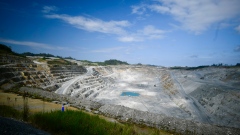May 8, 2024
Chile’s Inflation Accelerates, Stoking Caution on Rate Cuts
, Bloomberg News

(Bloomberg) -- Chile’s consumer prices rose more than forecast last month, underscoring the central bank’s caution over further interest rate cuts after it spearheaded reductions in Latin American over the past year.
Prices increased 0.5% from March, above the 0.4% median estimate from analysts in a Bloomberg survey. The annual inflation rate rose to 4% from 3.7% in the chained series, the national statistics institute reported Wednesday.
Chile economists and traders expect the central bank to slow the pace of its easing cycle for the second straight time by delivering a half-point rate cut on May 23. Investors see the smaller drop after policymakers stressed global risks including higher rates for a more prolonged period. Still, cost-of-living forecasts remain anchored at the 3% target in the two-year policy horizon.
Read more: Chile Central Bank Sees Cautious Rate Cuts Amid Global Risks
“The slightly larger-than-expected rise in Chile’s inflation in April supports our view that the central bank will once again slow the pace of easing with a 50bp cut (to 6.00%) at its meeting later this month,” Kimberley Sperrfechter, Emerging Markets Economist at Capital Economics, wrote in a note.
Two-year swap rates, a gauge of interest rate expectations, jumped 10.5 basis points in morning trading following the inflation report.
Transportation Costs
Food and non-alcoholic beverages increased 0.7% on the month in April, driven by increases in dairy products and eggs, according to the statistics institute. Transportation gained 1.1% on higher costs of automobiles and gasoline.
On the other hand, clothing prices fell 1.9%, while alcoholic beverages and tobacco slipped 0.5% during the period.
Plans to extend one of the world’s biggest rate-cutting cycles remain intact as policymakers have already incorporated new global risks into their outlook, central bank President Rosanna Costa said in an interview last month. Decisions on further borrowing cost reductions will be cautious, taking into account macroeconomic developments, she said.
Since last July, policymakers have lowered borrowing costs to 6.5% from an over two-decade high of 11.25%.
The central bank has gotten some respite from recent gains in the peso, which has appreciated 4% since the last monetary policy meeting on April 2. A weaker currency fans inflationary pressures by making imports more expensive, and Chile is vulnerable given it’s a relatively small and open economy.
The coming months will be marked by waning consumer price increases and an improved economy, Finance Minister Mario Marcel said in an interview with Radio Infinita on Wednesday.
“The increases in the prices of fuels are going to slow down because of the decline in the dollar,” he said. “The fall in the dollar will lessen inflationary pressures.”
Chile’s central bank sees annual inflation at 3.8% in December and 3% at the end of 2025, according to estimates published last month. Marcel said it’s possible that annual inflation will end this year below the central bank’s estimate.
--With assistance from Giovanna Serafim.
(Adds finance minister comments from the 11th paragraph)
©2024 Bloomberg L.P.








